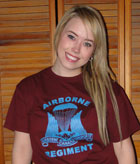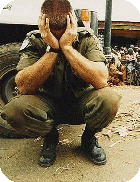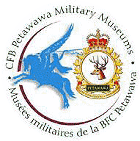The story of the Canadian Airborne Regiment
This is the history of the regiment as it was written before the disbandement of the unit.
Today's Canadian paratroopers can trace their roots back to two highly distinguished units: the first Canadian Parachute Battalion and the First Special Service Force.
The first Canadian Parachute Battalion was established on July 1st, 1942 with a Battalion headquarter, headquarters company, three rifle companies, and a total strength of 26 officers and 590 other ranks. Initially designated as a Home Guard Unit, the Battalion trained in Fort Benning, Georgia and then, at the newly established Parachute Training Center in Shilo, Manitoba. The unit was redesignated for active services and in July 1943 it left Canada for the United Kingdom where it joined the 6th British Airborne Division.
The Battalion's service in the European theatre included the Airborne invasion on D-Day, a short reinforcement stint in Belgium and Holland, the Airborne crossing of the Rhine and the subsequent advance to Wismar where they met the Russians. Its battle honors include: Normandy Landing, Dives Crossing, The Rhine and Northwest Europe 1944-45.
In June 1945, the Battalion returned to Canada, where, as it was the first unit to do so, it was greeted with a special “Welcome Home”. The unit was disbanded in the next months at Niagara-on-the-Lake.
The first Special Service Force began its history on July 10th, 1942 as a joint Canadian-United States formation for special operations in Europe. This unit later became known as the “Devil's Brigade.” Joint training was carried out in Helena, Montana prior to being sent into action. The First Special Service Force was initially deployed in the Aleutian Islands in the summer of 1943. In November of that year, it was deployed to Italy where it distinguished itself in the successful assault on Monte LaDifensa and Monte Remetanea. During its tour in Italy, the force saw action at Anzio and was the first allied unit to enter Rome. It was subsequently deployed to Europe where it saw the remainder of its action. On December 5th, 1944, the Force was disbanded near Menton, France. It had received the following battle honors: Monte Camino, Monte La Difensa, Monte La Remetanea, Monte Majo, Anzio, Rome, Advance to the Tiber, Italy 1943-44, Southern France and Northwest Europe.
Since World War II, paratrooping skills have been preserved in Canada through the formation of such organizations as The Canadian Special Air Service (SAS) Company, The Mobile Striking Force, The Defence of Canada Force, and currently the Canadian Airborne Regiment. The Canadian Special Air Service Company was formed in 1947 but was subsequently disbanded in 1949 after the Mobile Striking Force had been established in 1948. The MSF was an airborne brigade which was made up of various battalions from different units across Canada. This brigade was stationed at widely divergent locations in Canada, and it carried out continuation parachute training and arctic warfare until 1958 at which time the size of the force was reduced. Thereafter only companies of parachutists trained within the various battalions. This smaller unit was called the Defence of Canada Force.
On April 8th 1968, the charter for the formation of The Canadian Airborne Regiment was signed and the Regiment itself was formed in Edmonton. Initially organized as two infantry commandos, one artillery battery, one engineer field squadron, one signal squadron, and a service company, the Airborne Regiment was manned entirely by volunteers who were active paratroopers. Parachute instruction support was provided by the Canadian Airborne Center, while the Canadian Forces Parachute Maintenance Depot provided technical support. Both of these units are located in Edmonton.
On June 28th 1970, a mechanized infantry battalion was added to the Regiment and was named 3 Canadian Mechanized Commando. This unit was an element of the 4th Canadian Mechanized Brigade and was stationed in CFB Baden, Germany. Although it was part of the Regiment it did not have a parachute role. In 1977, 3 Mechanized Commando disappeared from the order of battle and was renamed the 3rd Battalion, The Royal Canadian Regiment.
In April 1977, the Special Service Force was formed in Petawawa by the amalgamation of units from 2 Combat Group and the Canadian Airborne Regiment. This formation was created in order to provide a small general purpose force in central Canada which could quickly be inserted in any national or international theatre of operations.
This amalgamation transformed the Airborne Regiment into a mini-formation within the Special Service Force. The Airborne Regiment became the core to which other elements could be added to form the Airborne Battle Group. As a result of this transformation, The Canadian Airborne Regiment underwent a major reorganization in July 1977. The first Airborne Field Battery was disbanded and its role was assumed by E Battery (Para) 2nd Regiment Royal Canadian Horse Artillery. The first Airborne Field Squadron was also disbanded and its role was assumed by the Airborne Troop of 2nd Combat Engineer Regiment. An Airborne Evacuation Platoon and an Airborne Treatment Platoon were formed within Two Field Ambulance and are attached to the Regiment when the complete Airborne Battle Group is deployed.
After being in Petawawa for one year, in June 1978, the Regiment underwent another reorganization. The two existing airborne commandos were reduced in size and a third, 3 Airborne Commando, was formed.
At that point, the Canadian Airborne Regiment was composed of five separate units. The infantry element was composed of three airborne rifle commandos, combat service support was provided by the Airborne Service Commando and to exercise command and control, the Regiment had an Airborne Headquarters and Signal Squadron. The total strength of the Regiment in peace time was approximately 750 all ranks.
Effective June 24 1992, the Regiment experienced another reorganization which involved the transition to battalion size and organization. This organization incorporates five individual sub-units. The sub-units composition and tasks remain actively unchanged except the Airborne Regiment Signals Squadron has become the Airborne Headquarters Commando, which incorporates a Signals platoon.
The primary role of The Canadian Airborne Regiment is to provide a quick reaction force in support of national security, North American defense and international peace keeping. In addition to these roles, the Regiment must prepare for limited and general war in conjunction with other forces.
The Regiment is prepared for any task which may include deploying elements to specific areas of Canada as a deterrent force, or destroying enemy lodgments and/or recapturing vital points. It may also be required to act as a spearhead, deploying elements to seize or to construct an airfield for subsequent airlanding of large conventional forces. The Canadian Airborne Regiment is also required to be ready to deploy overseas for international peacekeeping duties.
The Canadian Airborne Regiment is Canada's strategic reserve force and as such is capable of rapid reaction. It is able to fulfill its many roles efficiently and professionally due to the high quality of both the training and soldiers in THE CANADIAN AIRBORNE REGIMENT



